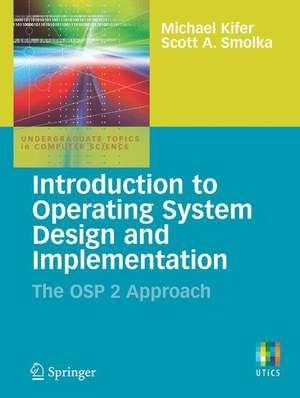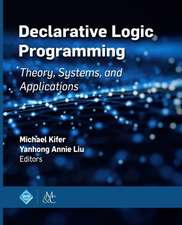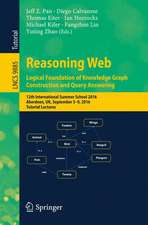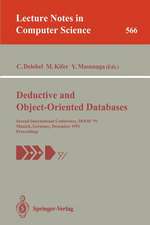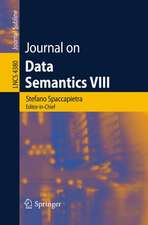Introduction to Operating System Design and Implementation: The OSP 2 Approach: Undergraduate Topics in Computer Science
Autor Michael Kifer, Scott Smolkaen Limba Engleză Paperback – 14 aug 2007
Topics and Features: Process and thread management; Memory, Resource and I/0 device management; Interprocess communication; Gives opportunity to practice these skills in a realistic operating systems programming environment.
This book contains enough projects for up to 3 semesters, exposing students to many essential features of operating systems, while at the same time isolating them from low-level machine-dependent concerns. Thus, even in 1 semester, students can learn about page-replacement strategies in virtual memory management, CPU-scheduling strategies, disk seek-time optimization & other issues in operating system design.
Din seria Undergraduate Topics in Computer Science
- 20%
 Preț: 287.02 lei
Preț: 287.02 lei - 20%
 Preț: 316.24 lei
Preț: 316.24 lei - 20%
 Preț: 350.89 lei
Preț: 350.89 lei - 20%
 Preț: 227.15 lei
Preț: 227.15 lei - 20%
 Preț: 187.22 lei
Preț: 187.22 lei - 20%
 Preț: 280.92 lei
Preț: 280.92 lei - 20%
 Preț: 306.71 lei
Preț: 306.71 lei - 20%
 Preț: 318.97 lei
Preț: 318.97 lei - 20%
 Preț: 258.78 lei
Preț: 258.78 lei - 20%
 Preț: 226.64 lei
Preț: 226.64 lei - 20%
 Preț: 179.87 lei
Preț: 179.87 lei - 20%
 Preț: 395.04 lei
Preț: 395.04 lei - 20%
 Preț: 225.02 lei
Preț: 225.02 lei - 20%
 Preț: 272.43 lei
Preț: 272.43 lei - 20%
 Preț: 306.58 lei
Preț: 306.58 lei - 20%
 Preț: 287.22 lei
Preț: 287.22 lei - 20%
 Preț: 305.01 lei
Preț: 305.01 lei - 20%
 Preț: 384.11 lei
Preț: 384.11 lei -
 Preț: 334.88 lei
Preț: 334.88 lei - 20%
 Preț: 305.61 lei
Preț: 305.61 lei - 20%
 Preț: 375.53 lei
Preț: 375.53 lei - 20%
 Preț: 276.82 lei
Preț: 276.82 lei - 20%
 Preț: 342.45 lei
Preț: 342.45 lei - 20%
 Preț: 254.37 lei
Preț: 254.37 lei - 20%
 Preț: 237.35 lei
Preț: 237.35 lei - 20%
 Preț: 316.07 lei
Preț: 316.07 lei - 20%
 Preț: 374.37 lei
Preț: 374.37 lei - 20%
 Preț: 245.43 lei
Preț: 245.43 lei - 20%
 Preț: 233.75 lei
Preț: 233.75 lei - 20%
 Preț: 307.16 lei
Preț: 307.16 lei - 20%
 Preț: 374.20 lei
Preț: 374.20 lei - 20%
 Preț: 246.39 lei
Preț: 246.39 lei - 20%
 Preț: 237.62 lei
Preț: 237.62 lei - 20%
 Preț: 463.43 lei
Preț: 463.43 lei - 20%
 Preț: 297.28 lei
Preț: 297.28 lei - 20%
 Preț: 304.44 lei
Preț: 304.44 lei - 20%
 Preț: 579.37 lei
Preț: 579.37 lei - 20%
 Preț: 298.18 lei
Preț: 298.18 lei - 20%
 Preț: 302.80 lei
Preț: 302.80 lei - 20%
 Preț: 300.89 lei
Preț: 300.89 lei - 20%
 Preț: 191.35 lei
Preț: 191.35 lei - 20%
 Preț: 243.35 lei
Preț: 243.35 lei - 20%
 Preț: 297.66 lei
Preț: 297.66 lei - 20%
 Preț: 278.10 lei
Preț: 278.10 lei - 20%
 Preț: 389.96 lei
Preț: 389.96 lei - 20%
 Preț: 184.28 lei
Preț: 184.28 lei - 20%
 Preț: 304.21 lei
Preț: 304.21 lei
Preț: 329.58 lei
Preț vechi: 411.98 lei
-20% Nou
Puncte Express: 494
Preț estimativ în valută:
63.07€ • 65.45$ • 52.72£
63.07€ • 65.45$ • 52.72£
Carte tipărită la comandă
Livrare economică 15-29 martie
Preluare comenzi: 021 569.72.76
Specificații
ISBN-13: 9781846288425
ISBN-10: 1846288428
Pagini: 188
Ilustrații: XII, 172 p. With online files/update.
Dimensiuni: 178 x 254 x 10 mm
Greutate: 0.34 kg
Ediția:2007
Editura: SPRINGER LONDON
Colecția Springer
Seria Undergraduate Topics in Computer Science
Locul publicării:London, United Kingdom
ISBN-10: 1846288428
Pagini: 188
Ilustrații: XII, 172 p. With online files/update.
Dimensiuni: 178 x 254 x 10 mm
Greutate: 0.34 kg
Ediția:2007
Editura: SPRINGER LONDON
Colecția Springer
Seria Undergraduate Topics in Computer Science
Locul publicării:London, United Kingdom
Public țintă
Lower undergraduateCuprins
Organization of OSP 2.- Putting it All Together: An Example Session with OSP 2.- Tasks: Management of Tasks (a.k.a. Processes).- Threads: Management and Scheduling of Threads.- Memory: Virtual Memory Management.- Devices: Scheduling of Disk Requests.- FileSys: The File System.- Ports: Interprocess Communication.- Resources: Resource Management.
Recenzii
From the reviews:
"This book is a manual for a hands-on computer science course on design principles and algorithms of modern operating systems. To convey essential features of today’s operating systems, the authors have contrived an operating system framework, called OSP 2, written in Java, in order to assign projects that implement management of important operating system features." (Rainer Horsch, Zentralblatt MATH, Vol. 1130 (8), 2008)
"This book is a manual for a hands-on computer science course on design principles and algorithms of modern operating systems. To convey essential features of today’s operating systems, the authors have contrived an operating system framework, called OSP 2, written in Java, in order to assign projects that implement management of important operating system features." (Rainer Horsch, Zentralblatt MATH, Vol. 1130 (8), 2008)
Textul de pe ultima copertă
Understanding the main principles and algorithms underlying a modern operating system is essential in undergraduate computer science. The complexity of this subject, however, means that mastering it requires significant practical experience. This unique book accomplishes just that: it teaches introductory subjects in OS design and implementation through hands-on engagement with OSP 2, the next generation of the highly popular OSP courseware.
This book exposes students to many essential features of operating systems while at the same time isolating them from low-level, machine-dependent concerns. With its accompanying software, the book contains enough projects for up to three semesters. Even one semester's study, however, suffices to cover page-replacement strategies in virtual memory management, CPU scheduling strategies, disk seek-time optimization and other issues in operating system design.
Features include:
• Provides an opportunity to practice OS design and implementation skills in a realistic, flexible, and easy-to-use systems programming environment that promotes "active learning" and reinforces lecture material.
• OSP 2 is written in Java, so that students learn an object-oriented approach to OS design and implementation.
• Contains many pedagogical tools: chapter goals, internet support for students and instructors; OSP 2 courseware and an instructors' manual, which includes helpful tips for course instructors and sample assignments, is available at www.springer.com/978-1-84628-842-5.
• Each chapter includes self-contained explanations of the OS concepts underlying the student project for that chapter.
Written for undergraduates in a first operating systems course, this text provides essential foundations through the user-friendly, highly flexible OSP 2 courseware environment.
This book exposes students to many essential features of operating systems while at the same time isolating them from low-level, machine-dependent concerns. With its accompanying software, the book contains enough projects for up to three semesters. Even one semester's study, however, suffices to cover page-replacement strategies in virtual memory management, CPU scheduling strategies, disk seek-time optimization and other issues in operating system design.
Features include:
• Provides an opportunity to practice OS design and implementation skills in a realistic, flexible, and easy-to-use systems programming environment that promotes "active learning" and reinforces lecture material.
• OSP 2 is written in Java, so that students learn an object-oriented approach to OS design and implementation.
• Contains many pedagogical tools: chapter goals, internet support for students and instructors; OSP 2 courseware and an instructors' manual, which includes helpful tips for course instructors and sample assignments, is available at www.springer.com/978-1-84628-842-5.
• Each chapter includes self-contained explanations of the OS concepts underlying the student project for that chapter.
Written for undergraduates in a first operating systems course, this text provides essential foundations through the user-friendly, highly flexible OSP 2 courseware environment.
Caracteristici
Contains enough projects for up to 3 semesters These projects expose students to essential features of operating systems, whilst isolating them from low-level machine-dependent concerns An Instructors Manual details how to use the OSP Project Generator and sample assignments The OSP courseware itself is available to instructors A complementary website provides support for both students and instructors using OSP 2 Includes supplementary material: sn.pub/extras Request lecturer material: sn.pub/lecturer-material
